Spatiotemporal Evolutions of the Suspended Particulate Matter in the Yellow River Estuary, Bohai Sea and Characterized by Gaofen Imagery
Abstract
:1. Introduction
2. Study Area and Data Prepare
2.1. Overview of the Study Area
2.2. Data Acquisition
2.2.1. Spectral Data
2.2.2. Processing of the In Situ TSM Data
2.2.3. Remote Sensing Data Processing
3. TSM Algorithm Establishment
3.1. Validation of the Atmospheric Correction
3.2. Characterization of Spectral Data and Equivalent Remote Sensing Reflectance
3.3. Bands Sensitive Analysis and TSM Inversion Algorithm
4. Results and Discussion
4.1. The Spatial TSM Distribution in the Bohai Sea
4.2. Quantifying the Spatiotemporal Distribution of TSM in the Yellow River estuary
4.3. Analysis of Factors Driving TSM Variations in the Yellow River Estuary
4.3.1. Wind, Wind Waves, and Storm Surge
4.3.2. Human Activities
5. Conclusions
- (1)
- We quantified the evolution and spatiotemporal TSM variations in the Bohai Sea using a optimal classification algorithm developed using in situ measured TSM data applied on the GF-6/GF-1 satellite image data. The peak of the measured remote sensing reflectance in the Bohai Sea region appears near the wavelength of 580 nm. Based on the correlation analysis between the GF Band 1, Band 2, Band 3, and Band 4 equivalent remote sensing reflectance and the in situ measured-TSM and the atmospheric correction accuracy evaluation, an exponential model was established by taking the ratio of Band 1 and Band 2 equivalent remote sensing reflectance as the remote sensing factor, and the R2 value of the model was 0.76. The inversion results suggest that the model can improve the characterization of the spatiotemporal distribution of TSM in the Bohai Sea region using GF images.
- (2)
- The spatiotemporal variations and the pattern distributions of the Yellow River estuary TSM was obvious. High TSM of water bodies was mainly concentrated in Bohai Bay, Laizhou Bay, and the Yellow River estuary near the sea, and the TSM was high near-shore and low offshore. The TSM in the Yellow River estuary sea showed an overall time distribution of being high in the spring and winter and low in summer and autumn.
- (3)
- Yellow River runoff can affect the TSM in the Yellow River estuary. The Yellow River estuary carries a large amount of sediment into the Bohai Sea every year, and the area near the mouth of the Yellow River is affected by the Yellow River runoff; as the flow of the Yellow River runoff rises, the TSM concentration increases, so does the scope of influence. Bohai Bay and Laizhou Bay are less affected by the Yellow River runoff. This is because the sediment carried by the Yellow River runoff enters the Bohai Sea and then falls rapidly and is deposited mostly in the area near the mouth of the Yellow River; however, the deposited sediment is redistributed under the action of wind, tide, waves, and currents, and it can be transported to Bohai Bay, Laizhou Bay and other areas, and even into the Yellow Sea.
Author Contributions
Funding
Data Availability Statement
Conflicts of Interest
References
- Hu, Y.; Yu, Z.; Zhou, B.; Li, Y.; Yin, S.; He, X.; Peng, X.; Shum, C.K. Tidal-Driven Variation of Suspended Sediment in Hangzhou Bay Based on GOCI Data. Int. J. Appl. Earth Obs. Geoinf. 2019, 82, 101920. [Google Scholar] [CrossRef]
- He, X.; Bai, Y.; Pan, D.; Huang, N.; Dong, X.; Chen, J.; Chen, C.T.A.; Cui, Q. Using Geostationary Satellite Ocean Color Data to Map the Diurnal Dynamics of Suspended Particulate Matter in Coastal Waters. Remote Sens. Environ. 2013, 133, 225–239. [Google Scholar] [CrossRef]
- He, X.; Bai, Y.; Pan, D.; Tang, J.; Wang, D. Atmospheric Correction of Satellite Ocean Color Imagery Using the Ultraviolet Wavelength for Highly Turbid Waters. Opt. Express 2012, 20, 20754. [Google Scholar] [CrossRef] [PubMed]
- Chen, Q.; Zhou, B.; Yu, Z.; Wu, J.; Tang, S. Detection of the Minute Variations of Total Suspended Matter in Strong Tidal Waters Based on GaoFen-4 Satellite Data. Remote Sens. 2021, 13, 1339. [Google Scholar] [CrossRef]
- Zhang, D.; Pang, C.; Liu, Z.; Jiang, J. Winter and Summer Sedimentary Dynamic Process Observations in the Sea Area off Qinhuangdao in the Bohai Sea, China. Front. Earth Sci. 2023, 11, 1097033. [Google Scholar] [CrossRef]
- Zhou, Z.; Bian, C.; Wang, C.; Jiang, W.; Bi, R. Quantitative Assessment on Multiple Timescale Features and Dynamics of Sea Surface Suspended Sediment Concentration Using Remote Sensing Data. J. Geophys. Res. Oceans 2017, 122, 8739–8752. [Google Scholar] [CrossRef]
- Kong, J.L.; Sun, X.M.; Wong, D.W.; Chen, Y.; Yang, J.; Yan, Y.; Wang, L.X. A Semi-Analytical Model for Remote Sensing Retrieval of Suspended Sediment Concentration in the Gulf of Bohai, China. Remote Sens. 2015, 7, 5373–5397. [Google Scholar] [CrossRef]
- Li, P.; Ke, Y.; Bai, J.; Zhang, S.; Chen, M.; Zhou, D. Spatiotemporal Dynamics of Suspended Particulate Matter in the Yellow River Estuary, China during the Past Two Decades Based on Time-Series Landsat and Sentinel-2 Data. Mar. Pollut. Bull. 2019, 149, 110518. [Google Scholar] [CrossRef]
- Liu, H.; Li, Q.; Shi, T.; Hu, S.; Wu, G.; Zhou, Q. Application of Sentinel 2 MSI Images to Retrieve Suspended Particulate Matter Concentrations in Poyang Lake. Remote Sens. 2017, 9, 761. [Google Scholar] [CrossRef]
- Wang, X.; Wen, Z.; Liu, G.; Tao, H.; Song, K. Remote Estimates of Total Suspended Matter in China’s Main Estuaries Using Landsat Images and a Weight Random Forest Model. ISPRS J. Photogramm. Remote Sens. 2022, 183, 94–110. [Google Scholar] [CrossRef]
- Zheng, Z.; Li, Y.; Guo, Y.; Xu, Y.; Liu, G.; Du, C. Landsat-Based Long-Term Monitoring of Total Suspended Matter Concentration Pattern Change in the Wet Season for Dongting Lake, China. Remote Sens. 2015, 7, 13975–13999. [Google Scholar] [CrossRef]
- Wang, X.; Song, K.; Liu, G.; Wen, Z.; Shang, Y.; Du, J. Development of Total Suspended Matter Prediction in Waters Using Fractional-Order Derivative Spectra. J. Environ. Manag. 2022, 302, 113958. [Google Scholar] [CrossRef] [PubMed]
- Xu, J.; Gao, C.; Wang, Y. Extraction of Spatial and Temporal Patterns of Concentrations of Chlorophyll-a and Total Suspended Matter in Poyang Lake Using GF-1 Satellite Data. Remote Sens. 2020, 12, 622. [Google Scholar] [CrossRef]
- Cheng, Z.; Wang, X.H.; Paull, D.; Gao, J. Application of the Geostationary Ocean Color Imager to Mapping the Diurnal and Seasonal Variability of Surface Suspended Matter in a Macro-Tidal Estuary. Remote Sens. 2016, 8, 244. [Google Scholar] [CrossRef]
- Sokoletsky, L.; Fang, S.; Yang, X.; Wei, X. Evaluation of Empirical and Semianalytical Spectral Reflectance Models for Surface Suspended Sediment Concentration in the Highly Variable Estuarine and Coastal Waters of East China. IEEE J. Sel. Top. Appl. Earth Obs. Remote Sens. 2016, 9, 5182–5192. [Google Scholar] [CrossRef]
- Teixeira, L.C.; Mariani, P.P.; Pedrollo, O.C.; dos Reis Castro, N.M.; Sari, V. Artificial Neural Network and Fuzzy Inference System Models for Forecasting Suspended Sediment and Turbidity in Basins at Different Scales. Water Resour. Manag. 2020, 34, 3709–3723. [Google Scholar] [CrossRef]
- Hu, Z.; Pan, D.; He, X.; Bai, Y. Diurnal Variability of Turbidity Fronts Observed by Geostationary Satellite Ocean Color Remote Sensing. Remote Sens. 2016, 8, 147. [Google Scholar] [CrossRef]
- Holyer, R.J. Toward Universal Multispectral Suspended Sediment Algorithms. Remote Sens. Environ. 1978, 7, 323–338. [Google Scholar] [CrossRef]
- Aranuvachapun, S.; Walling, D.E. Landsat-MSS Radiance as a Measure of Suspended Sediment in the Lower Yellow River (Hwang Ho). Remote Sens. Environ. 1988, 25, 145–165. [Google Scholar] [CrossRef]
- Jensen, J.R.; Kjerfve, B.; Ramsey, E.W.; Magill, K.E.; Medeiros, C.; Sneed, J.E. Remote Sensing and Numerical Modeling of Suspended Sediment in Laguna de Terminos, Campeche, Mexico. Remote Sens. Environ. 1989, 28, 33–44. [Google Scholar] [CrossRef]
- Sathasivam, S.; Kankara, R.S.; Murugan, U.; Gunasekaran, P.; Palanisamy, T.; James, R.A. Influence of Suspended Sediment Loads on Coastal Hydrodynamics at Vengurla and Ratnagiri Part of the Western Coast of India. Arab. J. Geosci. 2021, 14, 2231. [Google Scholar] [CrossRef]
- Prasad, A.K.; Singh, R.P. Chlorophyll, Calcite, and Suspended Sediment Concentrations in the Bay of Bengal and the Arabian Sea at the River Mouths. Adv. Space Res. 2010, 45, 61–69. [Google Scholar] [CrossRef]
- Baban, S.M.J. The Use of Landsat Imagery to Map Fluvial Sediment Discharge into Coastal Waters. Mar. Geol. 1995, 123, 263–270. [Google Scholar] [CrossRef]
- Duane Nellis, M.; Harrington, J.A.; Wu, J. Remote Sensing of Temporal and Spatial Variations in Pool Size, Suspended Sediment, Turbidity, and Secchi Depth in Tuttle Creek Reservoir, Kansas: 1993. Geomorphology 1998, 21, 281–293. [Google Scholar] [CrossRef]
- Bi, N.; Yang, Z.; Wang, H.; Fan, D.; Sun, X.; Lei, K. Seasonal Variation of Suspended-Sediment Transport through the Southern Bohai Strait. Estuar. Coast. Shelf Sci. 2011, 93, 239–247. [Google Scholar] [CrossRef]
- Liu, K.; Zhang, D.; Xiao, X.; Cui, L.; Zhang, H. Occurrence of Quinotone Antibiotics and Their Impacts on Aquatic Environment in Typical River-Estuary System of Jiaozhou Bay, China. Ecotoxicol. Environ. Saf. 2020, 190, 109993. [Google Scholar] [CrossRef]
- Lu, S.; Deng, R.; Liang, Y.; Xiong, L.; Ai, X.; Qin, Y. Remote Sensing Retrieval of Total Phosphorus in the Pearl River Channels Based on the GF-1 Remote Sensing Data. Remote Sens. 2020, 12, 1420. [Google Scholar] [CrossRef]
- Tang, J.; Tian, G.; Wang, X.; Wang, X.; Song, Q. The Methods of Water Spectra Measurement and Analysis I: Above-Water Method. J. Remote Sens. 2004, 8, 37–44. [Google Scholar]
- Yangdong, L.; Zhenyu, W.; Liang, C. A new method for estimating surface suspended sediment concentration in the Bohai Sea based on GOCI images. Mar. Lake Bull. 2020, 44, 80–88. [Google Scholar]
- Cui, T.W.; Zhang, J.; Wang, K.; Wei, J.W.; Mu, B.; Ma, Y.; Zhu, J.H.; Liu, R.J.; Chen, X.Y. Remote sensing study on the distribution of suspended solids in the Bohai Sea. J. Oceanogr. 2009, 31, 10–18. [Google Scholar]
- Li, J.; Hao, Y.; Zhang, Z.; Li, Z.; Yu, R.; Sun, Y. Analyzing the distribution and variation of Suspended Particulate Matter (SPM) in the Yellow River Estuary (YRE) using Landsat 8 OLI. Reg. Stud. Mar. Sci. 2021, 48, 102064. [Google Scholar] [CrossRef]
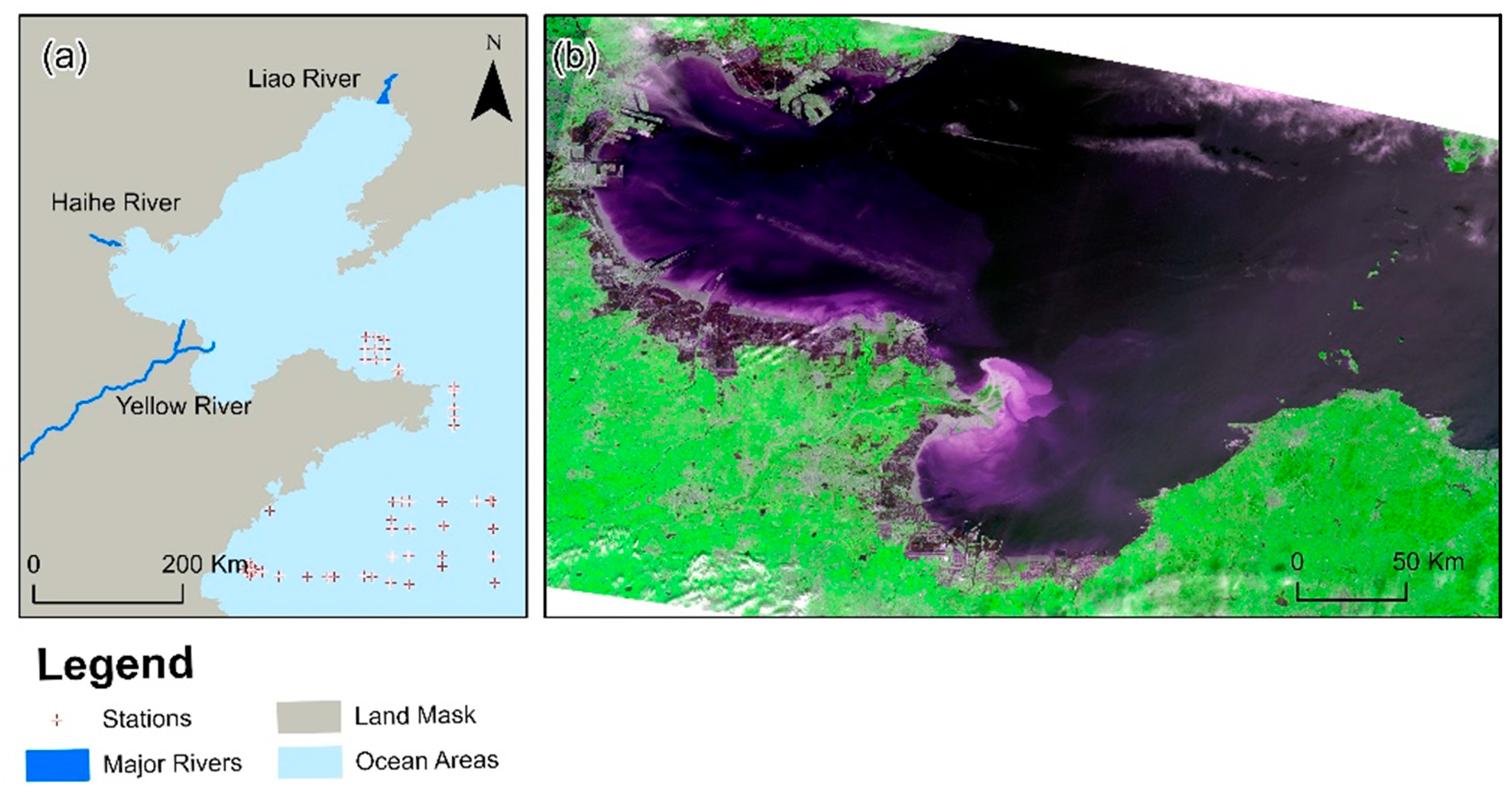
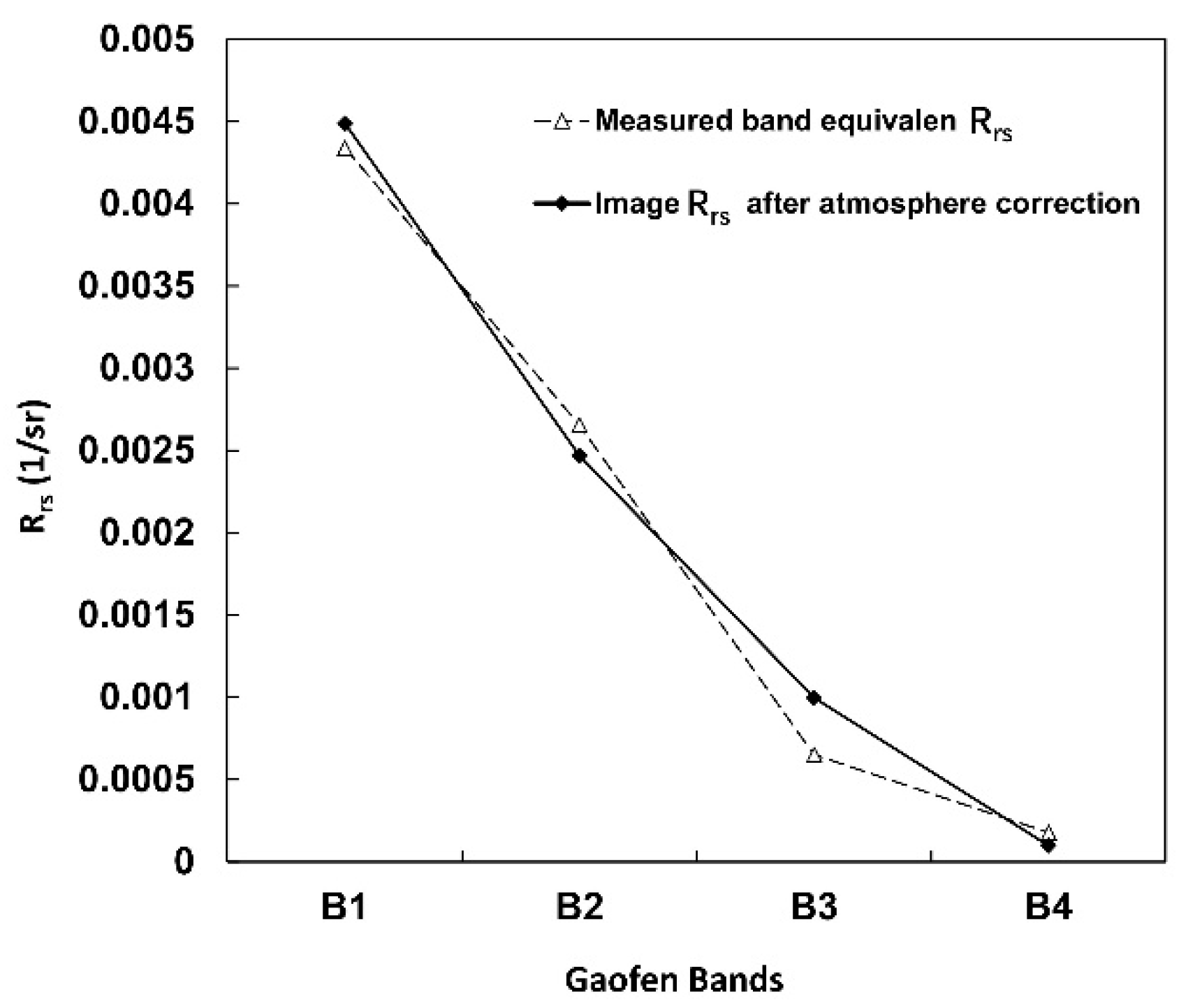

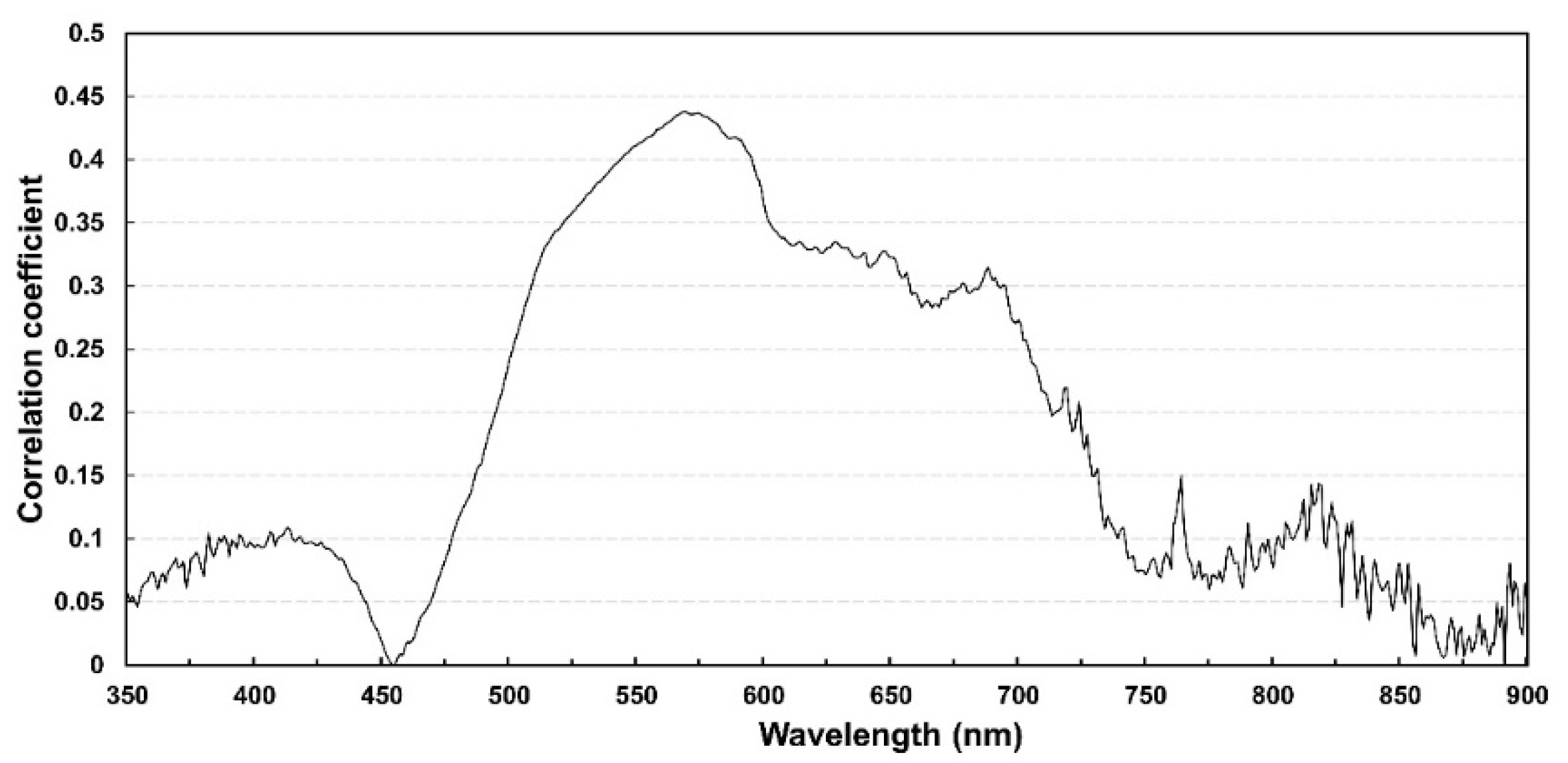

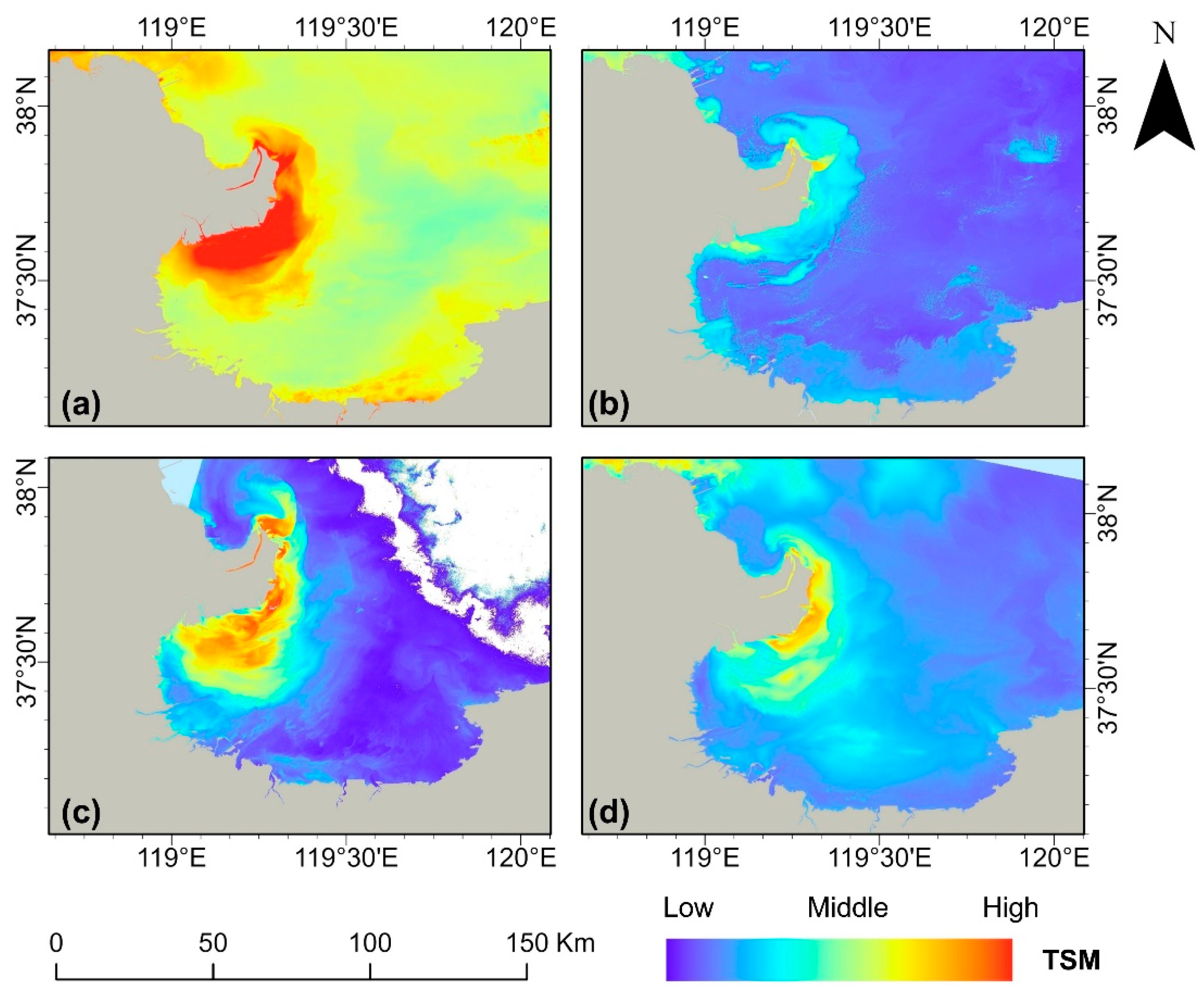
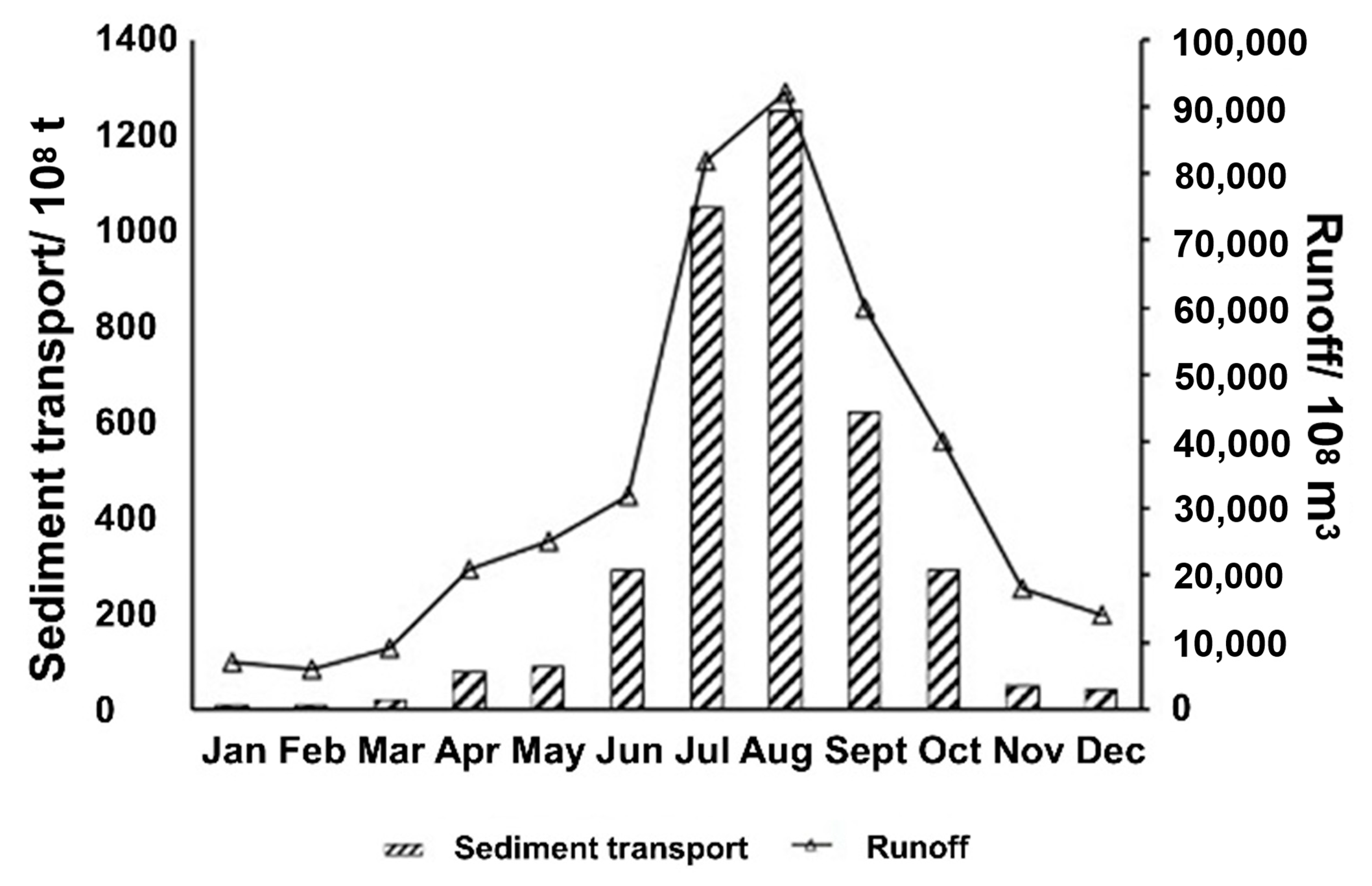
| Sensor | Band | Spectral Range/μm | Resolution/m |
|---|---|---|---|
| GF-1/GF-6 WFV | Band 1 (Blue) | 0.45–0.52 | 16 |
| Band 2 (Green) | 0.52–0.59 | ||
| Band 3 (Red) | 0.63–0.69 | ||
| Band 4 (NIR) | 0.77–0.89 |
| Models | Remote Sensing Factor (x) | TSM (y) Algorithm | R2 |
|---|---|---|---|
| Linear Function | B2/B1 | 0.71 | |
| Exponential Function | B2/B1 | 0.76 | |
| Power Function | B2/B1 | 0.74 | |
| Linear Function | (B2–B1)/(B2/B1) | 0.53 | |
| Exponential Function | (B2–B1)/(B2/B1) | 0.60 | |
| Polynomial Function | (B2–B1)/(B2/B1) | 0.68 | |
| Linear Function | B2–B1 | 0.74 | |
| Exponential Function | B2–B1 | 0.75 | |
| Polynomial Function | B2–B1 | 5 | 0.75 |
Disclaimer/Publisher’s Note: The statements, opinions and data contained in all publications are solely those of the individual author(s) and contributor(s) and not of MDPI and/or the editor(s). MDPI and/or the editor(s) disclaim responsibility for any injury to people or property resulting from any ideas, methods, instructions or products referred to in the content. |
© 2023 by the authors. Licensee MDPI, Basel, Switzerland. This article is an open access article distributed under the terms and conditions of the Creative Commons Attribution (CC BY) license (https://creativecommons.org/licenses/by/4.0/).
Share and Cite
Yu, Z.; Zhang, J.; Chen, Z.; Hu, Y.; Shum, C.K.; Ma, C.; Song, Q.; Yuan, X.; Wang, B.; Zhou, B. Spatiotemporal Evolutions of the Suspended Particulate Matter in the Yellow River Estuary, Bohai Sea and Characterized by Gaofen Imagery. Remote Sens. 2023, 15, 4769. https://doi.org/10.3390/rs15194769
Yu Z, Zhang J, Chen Z, Hu Y, Shum CK, Ma C, Song Q, Yuan X, Wang B, Zhou B. Spatiotemporal Evolutions of the Suspended Particulate Matter in the Yellow River Estuary, Bohai Sea and Characterized by Gaofen Imagery. Remote Sensing. 2023; 15(19):4769. https://doi.org/10.3390/rs15194769
Chicago/Turabian StyleYu, Zhifeng, Jun Zhang, Zheyu Chen, Yuekai Hu, C. K. Shum, Chaofei Ma, Qingjun Song, Xiaohong Yuan, Ben Wang, and Bin Zhou. 2023. "Spatiotemporal Evolutions of the Suspended Particulate Matter in the Yellow River Estuary, Bohai Sea and Characterized by Gaofen Imagery" Remote Sensing 15, no. 19: 4769. https://doi.org/10.3390/rs15194769





